35 Taal System/Thirty-Five Taal System/
Carnatic Taal System
Carnatic Taal System or 35 Taal System is the foundation and most important part of South Indian Classical Music. There are seven main Taals in south indian music - Ek, Rupak, Jhamp, Triput, dhruv, mathh, atth. The default matra value of laghu in carnatic taals is different, but when we change the jati of the taal, we change the value of laghu. Which directly affects the number of matras. In other words, we can say that this change forms a new taal. This is the method how 7 main taals transform into 35 taals. This 35 Taal system is the key of Carnatic Taal System.
Classification of Jati
Laghu has five Jaatis – Tisra(3), Chaturasra(4), Khanda(5), Misra(7), and Sankeerna(9); and by incorporating 7 Talas X 5 Jaatis, It creates a total of 35 Different Talas. For Example, Dhruva Tala which is representing chatushrajati has 4 2 4 4 ( | O | | ) have one Laghu of Chaturasra Jaati consist of 4 beat power followed by one Drut of 2 beats and two Laghus of 4 beats each. So, It forms a taal with a total number of 14 Beats.
Now, When we change the power of laghu to 3 to transform its jati to Tisra Jaati. It becomes 3 2 3 3 ( | O | | ) 11 Beats Taal. This method is used to change jati of the taal which creates 35 Taals known as the Carnatic Taal System. Now we are adding a chart of all 7 taals showing the change of jati for your reference. This is important to learn because it is the base of Carnatic music.
Taals and their Jati transformation Chart
Ek Talam – The Natural Value of Laghu is 4 in this Talam.
Rupak Talam – The Natural Value of Laghu is 4 in this Talam.
Aadi/Triput Talam – The Natural Value of Laghu is 3 in this Talam.
Jhamp Talam – The Natural Value of Laghu is 7 in this Talam.
Matya Talam – The Natural Value of Laghu is 4 in this Talam.
Dhruv Talam – The Natural Value of Laghu is 4 in this Talam.
Ata Talam – The Natural Value of Laghu is 5 in this Talam.
३५ तालों की प्रणाली
३५ तालों की प्रणाली दक्षिण भारतीय संगीत की आधारशिला तथा अभिन्न अंग है | दक्षिण भारतीय संगीत पद्धति में ७ मुख्य तालें है – एक, रूपक, झंप, त्रिपुट, अठ, मंठ, ध्रुव | इसमें लघु की मात्रा संख्या को ४ माना जाता है, परन्तु लघु की मात्रा संख्या में बदलाव करके ताल की जाति बदली जा सकती है, जोकि सीधे- सीधे ताल की मात्रा संख्या पर अपना असर दिखाते हुए नयी ताल का निर्माण करती है | इसी तरीके से ७ तालों में से ३५ तालों का निर्माण होता है |
जाति का वर्गीकरण
लघु की ५ जातियां होती हैं - तिस्र(३), चतुश्र(४), खंड(५), मिश्र(७) तथा संकीर्ण(९) | उदाहरण स्वरूप, ध्रुव ताल जो चतुश्र जाति की ताल है की संरचना ४ २ ४ ४ ( | O | | ) है, जिससे हमें १४ मात्रा के ताल की प्राप्ति होती है |
अब यदि हम लघु की संख्या को बदलकर ३ करदें तो यह तिस्र जाति ३ २ ३ ३ ( | O | | ) की ११ मात्रा की ताल बन जाएगी | जाति बदलने का यही नियम ३५ तालों की रचना करता है | अब हम ७ मुख्य तालों की जाति बदलने के क्रम को चार्ट के माध्यम से समझेंगे |
ताल तथा उनका जातीय प्रारूप
एक तालम - इस ताल में लघु की प्राकृतिक मात्रा ४ है।
रूपक तालम - इस ताल में लघु की प्राकृतिक मात्रा ४ है।
आदि/त्रिपुट तालम - इस ताल में लघु की प्राकृतिक मात्रा ३ है।
झम्प तालम - इस ताल में लघु की प्राकृतिक मात्रा ७ है।
मठ्य तालम - इस ताल में लघु की प्राकृतिक मात्रा ४ है।
अठ तालम - इस ताल में लघु की प्राकृतिक मात्रा ५ है।
ध्रुव तालम - इस ताल में लघु की प्राकृतिक मात्रा ४ है।
In conclusion after all the above discussion we can say that this 35 taal system is a key feature to carnatic music. However raag is also important but this music sytle is basically depend on taal system. Therefore we can say that change in laghu of any taal can transform it to a new jati or taal.

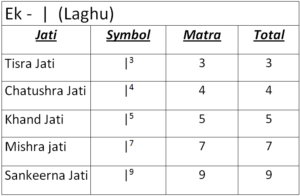
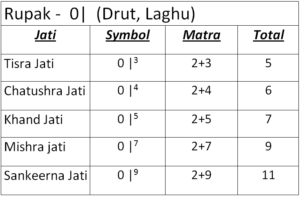
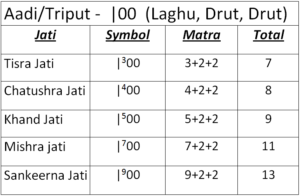
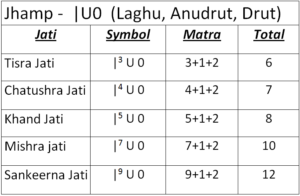
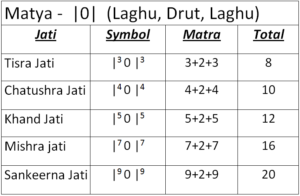
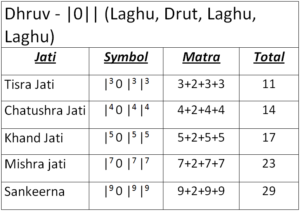
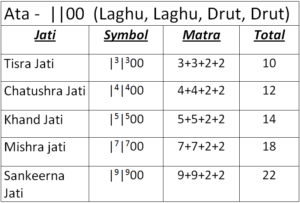



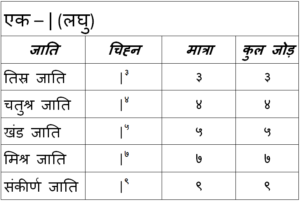
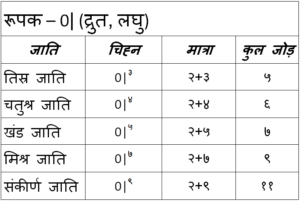

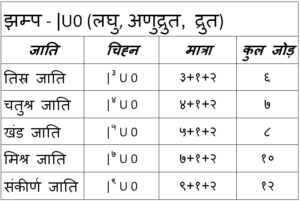
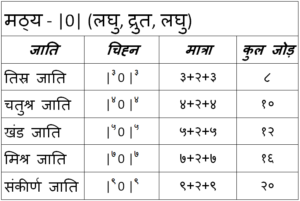
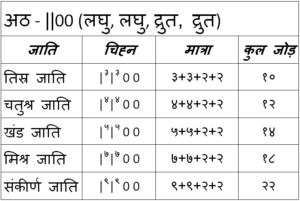
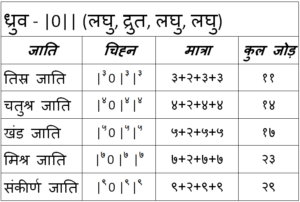
You must be logged in to post a comment.